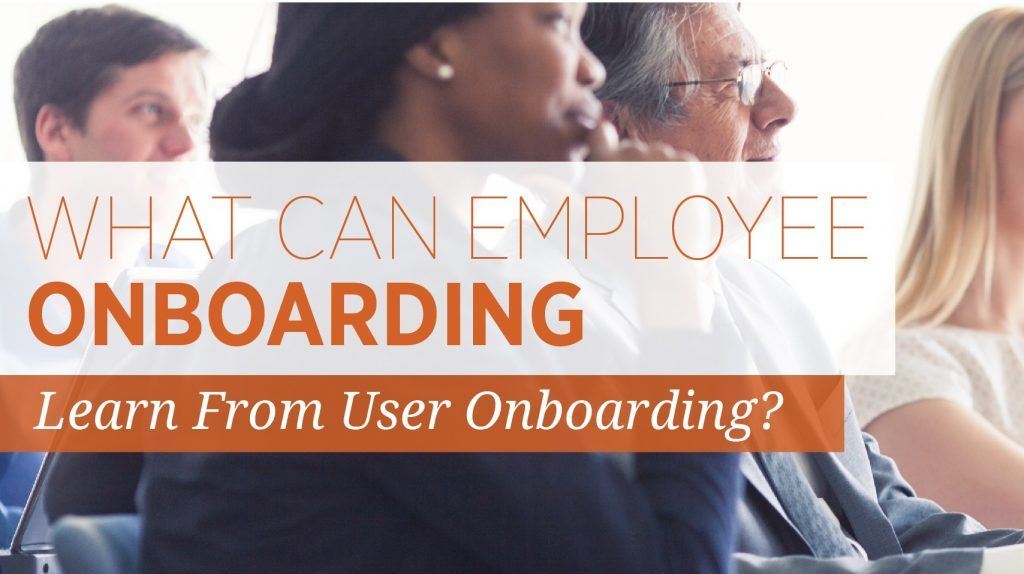3 Things Employee Onboarding Can Learn From User Onboarding
The goal of employee onboarding is to help new hires adjust to their new environment, but it takes guidance to begin performing to their full productive potential. Since employees can take time to adapt to change and the unique processes at each company, there’s a clear challenge in facilitating the smoothest transition process possible. Facilitating a good onboarding process is critical to employee success, so why do many companies still struggle with it? They don’t understand how to hook and sustain the onboarding experience. Luckily, these are things employee onboarding can learn from user onboarding.
Walking a customer through a new product or program carries many of the same challenges, but the stakes are even higher without the incentive of a paycheck to keep users interested. We can learn a lot from the tactics that successful user onboarding uses to keep its users... well, onboard.
Here are 3 things employee onboarding can learn from user onboarding.
1. The Goal: Increase Job Satisfaction
A 2014 article by Forbes suggests the majority of Americans aren’t satisfied at work. Satisfied employees tend to perform better and stick around, so it’s no surprise that increasing satisfaction is a top priority for employers.
In a similar respect, satisfaction is high stakes in user onboarding. Onboarding tasks must be satisfying, or users will never complete them.
The Strategy: Set Some Goals
Satisfying user onboarding experiences help users feel they're making progress because they break down big chunks of information into more manageable pieces. Progress becomes more visible and easy to track, and it’s more engaging for the user to complete tasks by exploring the content and learning how it works.
Setting clear objectives and expectations right from the beginning leads to higher levels of user satisfaction upon completion. Introducing new uncompleted tasks as others are completed helps them stick in the mind, and encouraging users to explore more adds intrinsic value to the presented content.
2. The Goal: Increase Performance
Good onboarding encourages high-quality performance by giving your new hires the skills they need to work well. The challenge is to provide quick learning that sticks with new employees and keeps them invested in the value of their work.
In contrast, user onboarding tends to be a little less concerned with performance output of customers, but there’s still the same focus on streamlining learning and providing incentives.
The Strategy: Teach In Ways That Resonate
A simple mantra that Appcues provides is Do > Show > Tell. The most successful customer onboarding experiences walk their users through the relevant procedures. Active participation is there right from the get-go. Not only is it more engaging, but it also helps a new user learn how to interact with an unfamiliar system or interface much faster.
Employee onboarding that really engages the new hire should maximize hands-on experiences by including activities that let learners “do” and keep lectures to a minimum.
User onboarding takes advantage of a psychological phenomenon called the Goal Gradient Effect. Essentially, this concept says the closer people are to achieving a goal, they more likely they are to work harder and engage with more effort. Good user onboarding maximizes this effect to invest a customer in goal completion. Strategies include visual cues and heightened sensory experiences as a user approaches their goal. Using this effect to your advantage in employee onboarding can encourage more effort -and better performance output- as your employee gets closer to completing their goals.
3. The Goal: Inoculate Against Turnover
Turnover is a controversial issue in user onboarding. Recruiting new users is hardly successful if none of them stick around. How many times have you downloaded an app or signed up for a free service only to never touch it again because it didn’t sufficiently engage your interest? In user onboarding, recruitment doesn’t stop on the date of sign up. To keep its users invested, effective onboarding provides incentive to keep coming back and performing.
Employee onboarding isn’t going to see the same immediate drop-off that a free app will have, but a corporate onboarding or new-hire program that engages employees will help companies decrease the turnover of those will leave within the first two years.
The Strategy: Self-Image And Commitment
Our brains love patterns because they give us quick, easy ways to make decisions on autopilot. These choices lead to the formation of our self-image, giving us incentives to be consistent with that image we’ve created. It doesn’t matter if changing up the pattern has some clear benefits. Staying consistent is the most friction-free path forward.
If a brand or identity is successfully integrated with a user’s self-image, they want to stick with it. The tricky part is fostering that kind of connection in a new environment. How do we help new employees incorporate their work into their sense of identity? In user onboarding, a proven strategy is to build commitment.
Commitment is a powerful tool you can use to ensure your user stays invested. A new user might encounter a prompt to set a goal, or "like" the product on social media in user onboarding. A small commitment like this helps cement the product in the user’s self-image, and therefore make much bigger commitments (like a paywall) later.
Final Thought
There’s a lot to learn from successful user onboarding experiences. Using these strategies in your employee onboarding could be key in helping reduce friction for your new hires as become a part of your company.
Looking for other ways to improve your onboarding? Read how video can contribute to better employee onboarding.








